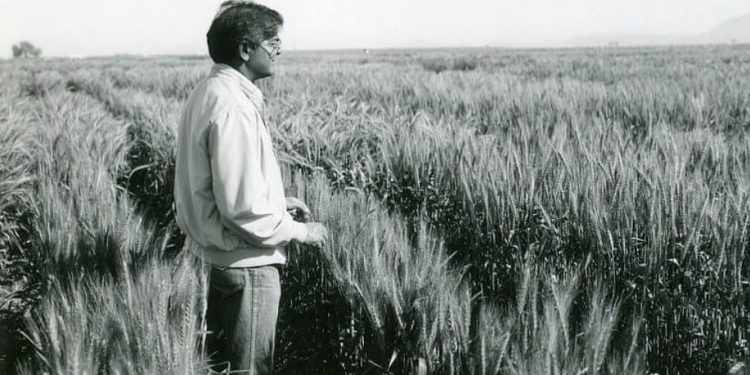The Indian government honoured an Indian-Mexican agricultural scientist with Padma Bhushan (posthumously), whose wheat variety has saved millions of lives globally.
Wheat, a crop that has revolutionised the entire humankind. And in the modern world, the change in climate conditions have affected the agriculture sector a lot. Scientists are working round the clock to enhance the crops that we grow. And recently, the Indian government honoured an Indian-Mexican agricultural scientist with Padma Bhushan (posthumously), whose wheat variety has saved millions of lives globally. The scientist goes by the name – Dr Sanjaya Rajaram. Back in 2001, the Government of India had awarded him the Padma Shri.
The Padma Bhushan award was received by Sanjaya Rajaram’s son, and he said, “We are very honoured that the govt has recognized Sanjaya Rajaram for Science and Engineering and awarded him Padma Bhushan (Posthumous)”
To continue his excellent work, Dr Sanjaya Rajaram has trained over 700 scientists in this field to continue what he has left. Let us dig deep into the path-breaking work of Dr Sanjaya which is admired globally.
High-yielding and disease-resistant wheat varieties by Dr Sanjaya Rajaram
Wheat is grown all over the world, and one thing that affects the crop is the disease it has which affects its yield. To boost the yielding of the wheat crop, Dr Sanjaya Rajaram developed high-yielding and disease-resistant wheat varieties that farmers grow across 51 countries.
The Indian born Scientist ranks among the most outstanding agricultural scientists of our time. Dr Sanjaya Rajaram’s incredible research is alone responsible for the development of 480 varieties of wheat, that are widely used across 6 continents. The process has impacted the wheat yield of planet earth, leading to an increase in global production by more than 200 million tonnes.
About Dr Sanjaya Rajaram
Dr Sanjaya Rajaram was born in 1943 near a small farming village in Uttar Pradesh. Rajaram’s family made their living out of a five-hectare farm by growing wheat, rice and maize. The young boy was curious about the world around him. Rajaram completed his primary and secondary education in the village only. At a time when roughly 96 per cent of the rural population had no formal education, Rajaram would travel five kilometres away from his home to attend School.
The young boy was never behind in his studies, eventually becoming the top-ranked student in the entire Varanasi district. From there he won a state scholarship to attend high school. After that in 1962, he went to the College of Jaunpur at the University of Gorakhpur, to complete his B.S. in agriculture.
In 1963, Rajaram travelled to Australia for his PhD in plant breeding at the University of Sydney on a scholarship from the Rotary Club of Narrabri. Dr I.A. Watson was Rajaram’s professor and mentor at the University of Sydney. Watson recommended Rajaram to Dr Borlaug and Dr Glenn Anderson at the International Maize and Wheat Improvement Center (CIMMYT) in Mexico – and this set in motion Rajaram’s distinguished scientific career in wheat research.
In 1969, Rajaram’ began his research and field at CIMMYT (International Maize and Wheat Improvement Center). In 1972, Borlaug asked Rajaram to succeed him and head up the wheat breeding team at CIMMYT. Rajaram has said that the following year was a learning phase during which he came to realize the diversity in wheat and began experimenting with cross-breeding winter and spring wheat varieties. In this regard, Rajaram agreed with Borlaug concerning the importance of hands-on field research, the application of science and the practical approach to achieving results.
Apart from increasing the world’s production of wheat, Rajaram’s wheat varieties reached marginal areas, such as small mountain plots in Pakistan and remote areas in China. One of the most important contributions was his development of aluminium-tolerant wheat that was able to grow successfully in the acidic soils of Brazil.
Rajaram also developed wheat cultivars with durable resistance to rusts—the most damaging disease to wheat worldwide—through his concept of “slow rusting.” He used multiple genes with minor effects that slow down disease development, thereby minimizing the impact on yield without challenging the rust pathogen to mutate and overcome resistance.
Rajaram also worked with the International Center for Agricultural Research in the Dry Areas (ICARDA) as the Director of the Integrated Gene Management Program and retired in 2008, but continued as a special scientific advisor on overall wheat improvement strategies.
In 2007, Dr Borlaug expressed high praise for Rajaram in a personal note and wrote: “You have developed into the greatest present-day wheat scientist in the world… have made and continue to make many important contributions to further improve world wheat production… have learned to work effectively in many different countries with political leaders of different ideologies… and are a scientist of great vision.”
Dr Rajaram passed away on 17 February 2021 at his home in Ciudad Obregón, a city in the Sonora province of Mexico. His contribution to the agriculture sector has been immense. He will be remembered as one of the great agricultural scientists who reshaped the world with his work.
Follow NRI Affairs on Facebook and Twitter for latest updates. Support us on Patreon.











